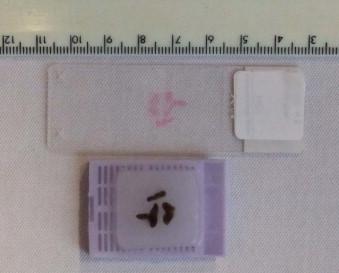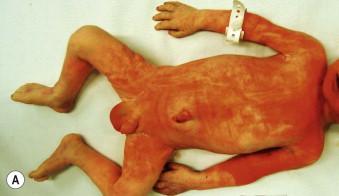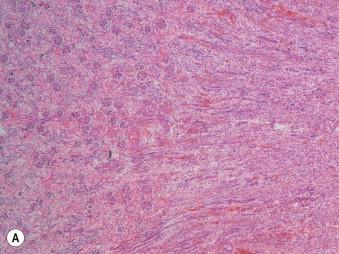Physical Address
304 North Cardinal St.
Dorchester Center, MA 02124
Perinatal/paediatric pathology is a medical subspecialty with particular expertise in diseases affecting the placenta, fetus, infant and child. In the United Kingdom, paediatric pathology has evolved rapidly over recent decades from a small area of practice for general histopathologists, to becoming a recognized subspecialty by the Royal College of Pathologists.
The workload of a practising paediatric pathologist can be broadly separated into two fields:
Surgical pathology; examining and reporting tissue biopsies and specimens.
Performing autopsies and placental examinations.
Whilst, fortunately, the majority of prenatally diagnosed conditions will not require the contribution of a paediatric pathologist, there are three main settings in which the fetal medicine specialist may interact with this service, namely:
terminations or fetal/infant deaths undergoing postmortem examination (autopsy);
histopathological examination of the delivered placenta;
prenatal diagnosis of specific conditions in which examination of a tissue sample is required.
Advances in prenatal diagnosis and obstetric care, including the management of complex pregnancies and increasingly sophisticated methods of antenatal imaging, have led to a parental and professional demand for detailed investigation of the underlying pathology. This can provide subsequent advice for future pregnancies and has become the standard of care. Within the framework of this chapter, it is not possible to describe in detail the pathology of a wide range of conditions, which can be obtained from specialist texts, but an overview of paediatric pathology for the practising fetal medicine/obstetric specialist will be provided to highlight relevant issues regarding the most commonly encountered entities, as well as providing some practical guidelines and recommendations for optimal incorporation of fetal pathology into the overall setting of a fetal medicine/prenatal diagnosis service.
Within the UK, it is recommended by the Royal College of Obstetricians that the option of an autopsy should be offered to all parents where a perinatal death has occurred; including first and second trimester miscarriages, stillbirths and terminations of pregnancy, and these examinations should be performed by a specialist paediatric pathologist . In this section, the role of the perinatal autopsy will be discussed, including factors contributing to the reduction in the numbers of traditional autopsies, specifically regarding parents' and clinicians' attitudes towards postmortem examinations. Current issues surrounding consent, which is required for the majority of perinatal autopsies, will be addressed, with particular reference to legislation in the UK and the Human Tissue Act, which came into force in September 2006 (Human Tissue Act, 2004 (The Human Tissue Authority, 2008)). The differences between consented (hospital) perinatal postmortem examinations and coronial autopsies in peripartum/neonatal death cases will be clarified and the postmortem procedure itself will be discussed, including the recent development of novel autopsy techniques, and practical issues regarding performance of the autopsy in a service setting will be addressed.
The role of the autopsy is multi-faceted and includes:
Determination of the cause of death.
Recognition of unsuspected or associated findings.
Provision of additional information for clinicians and parents for future pregnancies and current siblings.
Audit and assessment of current clinical practice including confirmation of findings from ultrasound.
Identification of potential pathologies with public health implications.
Findings regarding possible associations and outcomes guiding new technologies and treatment modalities.
Data from a review of 27 studies examining discrepancy between clinical diagnosis and autopsy findings demonstrated that the perinatal postmortem examination resulted in a ‘change in diagnosis’ or ‘additional findings’ which might have influenced management or counselling in 22–76% of cases, the rate varying from 28–75% for stillbirths, 22–49% for terminations of pregnancy, and 22–81% for neonatal deaths. Importantly, up to 35% of antenatal ultrasound diagnoses were modified by additional findings at autopsy. Furthermore, a study of 309 terminations of pregnancy for prenatally diagnosed abnormalities reported that, of the 132 cases (which were chromosomally normal but found to have a structural defect on antenatal ultrasound examination) undergoing postmortem examination, the autopsy revealed additional findings which modified the recurrence risk in almost one third of cases.
There are two major categories of perinatal postmortem examination in the UK, consented autopsies and those performed on behalf of HM Coroner.
Cases referred to the coroner include those in which:
The cause of death is unknown, or sudden and unexpected.
The death occurred during an operation or before recovery from the effects of an anaesthetic.
The deceased infant was not seen by the certifying medical practitioner, either after death or within 14 days of death.
The death may have been caused by violence or neglect.
The death may have been due to an accident.
The death may have been in any other way unnatural or there are suspicious circumstances.
Clearly, in relation to perinatal autopsies, the major cases referable to the coroner are neonatal deaths in which there is suspicion of neglect or accident. If there is a potential issue of litigation due to neglect by hospital staff, the case should also always be discussed with HM Coroner. If a coroner's postmortem examination is performed, parental consent is not required and the coroner's decision overrides that of the parents. Once the coroner has completed the investigation, all tissue samples taken as part of the postmortem examination will then fall under the Human Tissue Act (see below) and should be handled according to parents' wishes.
However, the vast majority of perinatal postmortem examinations will not be on behalf of the coroner and will therefore require consent by one or both parents. The Human Tissue Act (2004), overseen by the Human Tissue Authority (HTA) in the UK, is responsible for defining standards, published as codes of practice, and licenses organizations and establishments that deal with human tissue (The Human Tissue Authority, 2008).
The HTA specifies that informed consent is required for the removal, storage and use of human tissues, including small samples such as blocks and slides which might be kept as part of the medical record, and therefore includes consent to perform a postmortem examination. However, the details of the Act only strictly apply to stillbirths and neonatal deaths. Fetuses born dead at <24 weeks' gestation are not regarded as having independent life and under the Act are subject to consent requirements for tissue from the mother. However, for ease of application and sensitivity regarding autopsy practice, it is recommended that consent be obtained for postmortem examination of all fetal tissue regardless of the gestational age.
Consent for autopsy must be given voluntarily by an appropriately informed person who has the capacity to agree to the activity, which for perinatal postmortem examinations will usually be one or both parents. It is recommended that, where possible, consent is obtained from the mother, and that, where appropriate, both parents are involved. Consent from one parent is sufficient. Parents may of course withdraw consent at a later stage. It is the clinician's (who should be sufficiently senior and well informed, with knowledge of the postmortem procedure) responsibility to seek consent. As valid consent can only be given if appropriate communication has taken place, information leaflets and consent forms should be available in the main local community languages for patients whose first language is not English, and interpreters should be used. Written consent is not required by law, although usually required by the local hospital policy.
As can be seen from the above section, since the introduction of the HTA, the requirements and criteria for gaining consent for postmortem examination are somewhat complicated in order to fulfil the stipulated conditions. In our experience, the most common practical problem affecting the process of perinatal autopsy examination is incorrectly completed consent forms, which may then delay the performance of the examination. It is highly recommended that a member or members of the clinical team lead on this process and establish systems for reliable and accurate consenting. The pathologist undertaking the examination should also be available to provide advice and guidance as required. Parents should be informed that samples obtained (blocks and slides; Figure 22-1 ) will be kept as part of the medical record, as in life, and that if these are destroyed according to parents, wishes, it will not be possible to review the case or perform additional tests at a later date if new information becomes available.

Whilst consent is being discussed, the body of the fetus or infant should be stored in a secure refrigerated unit (in order to delay postmortem autolysis and increase or improve of success for other investigations), ideally in the hospital mortuary. If skin or placental sampling is required for fibroblast culture for genetic studies, this should ideally be performed as soon as practical following delivery rather than waiting for the autopsy in order to optimize the sample for culture, especially if there may be delay due to the requirement to transfer the body to a specialist unit.
The body should be labelled with at least two identification markers, including maternal details, date of delivery and hospital number, and documentation must include the completed consent form and relevant clinical details, with particular regard to any specific questions that the parents or clinicians would like the postmortem examination to address. Prior to commencement of evisceration, it is routine to obtain full-body X-ray imaging, including anterior–posterior and lateral views to identify any skeletal abnormalities, although the benefit of this routine investigation remains undetermined. In some cases unexpected skeletal findings may be detected and skeletal biometry provides further indication of gestational age in cases where this is not known such as unbooked pregnancies.
Biometric measurements and body weight are then obtained, followed by an external examination for abnormalities and photographic documentation of such if required. It should be noted that there may be significant differences between birth weight and body weight at autopsy due to postmortem changes, primarily fluid loss. Such changes vary with duration of intrauterine retention and the postmortem interval, and should be accounted for when interpreting body weights for gestation.
Examination for dysmorphic features is performed and common findings which may not be detected antenatally are described in Table 22-1 .
| Findings | Common Associations | Issues |
|---|---|---|
| Orbital hyper/hypotelorism | Cranio-facial abnormalities, numerous genetic syndromes | Measurements based on normal ranges |
| Abnormal philtrum | Wolf–Hirschhorn syndrome; fetal alcohol syndrome | Measurements can be subjective |
| Dysmorphic ears | In the absence of deformational abnormalities of the ear, low-set ears may be difficult to interpret in the context of 'soft' dysmorphic signs. Focus on the presence of the internal auditory canal helps localize the correct position | |
| Cleft lip/palate | Isolated finding, midline defects, genetic syndromes | Isolated cleft palate is difficult to detect antenatally |
| Micrognathia | Trisomies/genetic syndromes | Determination of mandibular hypoplasia is particularly difficult in early gestational ages at postmortem, unless severe |
| Single palmar/plantar creases | Association with trisomy 13, 18 and 21 | 'Soft' dysmorphic signs such as single palmar creases can be difficult to interpret in macerated fetuses |
| Clinodactyly and overlapping fingers | Curvilinear isolated deformation of the digits as well as overlapping of fingers/toes are associated with trisomies | Identification of subtle limb malformations can be difficult at autopsy, due to postmortem drying of the hands and feet in small (fetuses, if incorrectly stored) |
| Syndactyly | Webbing/fusion of the fingers/toes can be an isolated finding or part of a genetic syndrome | Subtle abnormalities of the hands and feet are difficult to diagnose antenatally |
| Anorectal malformations | May be associated with antenatal bowel obstruction. Associated with genetic syndromes | Antenatal identification of minor malformations including imperforate anus is difficult antenatally, if obstruction is absent |
| Genital tract malformations | Range of syndromes associated with ambiguous genitalia | Sex/gonads should be determined by external and internal examination |
Subsequent examination proceeds with evisceration of the internal organs and detailed organ dissection. There are numerous protocols for this procedure, which vary according to the specific indication for autopsy, gestational age and pathologist preference. However, parents should be aware that a standard perinatal autopsy will involve a large midline incision from neck to pelvis, and if histological brain examination is required, an additional incision across the scalp. Following the procedure the organs are returned to the body, and the incisions are sutured or closed by other means.
Maceration (meaning to soften by soaking in liquid) is the process of post-fetal death change which occurs with retention in utero after death. The degree of maceration change increases with the duration of intrauterine retention, which allows some estimation to be made regarding the timing of an intrauterine death before delivery ( Table 22-2 ; Figure 22-2A and B ). Changes include skin slippage, ‘blistering’, discolouration and joint laxity.
| Timeline | Macroscopic Findings | Microscopic Findings |
|---|---|---|
| 6–12 hours | Desquamation (skin slippage). Noticeable over bony prominences, revealing shiny moist dermis | Loss of renal tubular nuclear basophilia |
| 24 hours | Formation of fluid-filled bullae between dermis and epidermis | Loss of basophilia of inner half of the myocardium |
| 48 hours | Dark red discolouration under areas of skin slippage. Over 50% desquamation. Internal organs become discoloured. Joint laxity noted | Loss of basophilia of the outer half of the myocardium |
| 3–4 days | Widespread subcutaneous oedema. Extensive desquamation (over 75%) | |
| 5 days | Overlapping cranial vault bones due to separation from dura and periosteum (Spalding's sign) | Loss of basophilia of bronchial epithelial cells and in the liver |
| 7–10 days | Skin discolouration from purple to brown | Continuing autolysis, in particular the GI tract and adrenal glands |
| >2 weeks | Mummification (with fading to yellow-grey) | Maximal loss of nuclear basophilia |

Autolysis is the process of cellular degeneration which occurs following death of an organism and loss of normal control of cellular metabolic and enzyme activity. This may coexist with putrification, the process of tissue degeneration due to bacterial activity, and maceration (see above). These processes are related to the temperature at which the body is stored following death/delivery, with any significant retention of the fetus in a warm environment (i.e. room temperature) hastening the rate of tissue degeneration. Extensive autolysis makes adequate macroscopic, and especially microscopic, examination difficult ( Figure 22-3A and B ).

According to current guidelines it is recommended that feticide is performed for termination of pregnancy beyond 21 weeks of gestation , which is usually performed by intracardiac injection of potassium chloride. Following feticide, it appears that the rate of autolytic change is increased, resulting in greater chance of non-diagnostic autopsy findings, especially when feticide is accompanied by prolonged intrauterine retention post intrauterine death and a long postmortem interval (cases where potassium administration was given were twice as likely to have discordant findings between ultrasound and postmortem findings ). This is especially important for terminations of pregnancy for cardiac and brain abnormalities, when autopsy findings are likely to be important for providing a specific diagnosis; in such cases the fetus should be stored in a refrigerated unit as soon as possible after the delivery and the autopsy should be performed within the shortest reasonable time period to minimize the risk of non-diagnostic findings. The mechanism is uncertain but may be due to combination of direct cytotoxic damage and autolysis, and development of tissue salt crystals.
If samples are required for karyotyping or fibroblast culture it is recommended that these are obtained as soon as possible following delivery (or prenatally) rather than at the time of autopsy, to maximize the chance of successful culture and analysis. Samples may therefore include fetal/cord blood, fetal skin biopsy or placental tissue biopsy, all of which may be used for karyotyping and subsequent molecular genetic examination. If there is a prolonged postmortem interval, samples obtained at the time of autopsy may be suboptimal for use. It should be noted that if a sample, either fetal or placental, is fixed in formalin/formaldehyde, it will not be suitable for fibroblast culture or standard karyotyping, although some specific molecular genetic testing with other techniques such as polymerase chain reaction may be possible.
The autopsy remains the current gold standard for the investigation of the cause of unexpected in-utero or neonatal deaths. In some cases, specific fetal and placental pathologies will be found to explain the death. It is important to recognize that, despite a full postmortem examination (with appropriate ancillary investigations), the majority of such deaths may remain unexplained. This is regardless of gestational age, and is especially true in the setting of clinically unexplained, unexpected late third trimester stillbirths.
In this context, numerous classification systems have been devised which include both clinical and autopsy findings to variable degrees, with the aim of establishing the likely underlying pathological process, if not the precise cause of death itself; for example, congenital abnormality, intrauterine infection and acute asphyxia. A recent review of four such classification systems reported that reclassifying deaths with some schemes (compared to the traditional and most commonly used Extended Wigglesworth Classification), reduced the incidence of apparently unexplained deaths. More recent classification systems include the TULIP and ReCoDe systems. However, it should be noted that regardless of the classification used, even when a potential underlying process, such as intrauterine growth restriction, is suggested, in most cases the exact cause or even mechanism of the death is not determined and for this reason there is no universally accepted classification system.
Become a Clinical Tree membership for Full access and enjoy Unlimited articles
If you are a member. Log in here